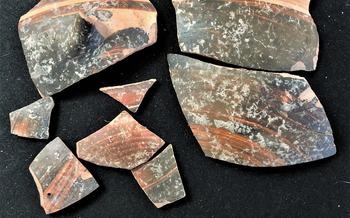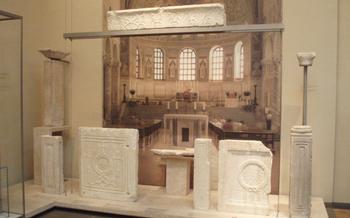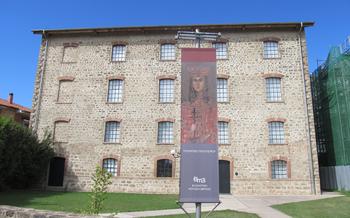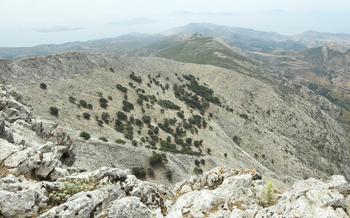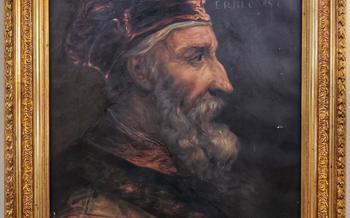
Naousa Byzantine Museum
- Historical Background
- Location and Accessibility
- Museum Hours and Admission Fees:
- Architectural Highlights
- Permanent Collection
- Temporary Exhibitions
- Guided Tours
- Educational Programs
- Accessibility for All
- Photography and Videography
- Nearby Attractions:
- Food and Beverage Options
- Visitor Tips:
- Insider Tip:
Historical Background
The Naousa Byzantine Museum stands as a testament to the rich history of Naousa, a picturesque town on the island of Paros in Greece. Naousa, once a prominent maritime center, played a significant role in the Byzantine Empire, a powerful civilization that spanned over a thousand years. The museum, housed in a beautifully restored 18th-century mansion, showcases a remarkable collection of artifacts that narrate the captivating story of Naousa's past.
The Byzantine Empire, with its capital in Constantinople, left an indelible mark on Greece, shaping its culture, religion, and artistic traditions. Naousa, with its strategic location in the Aegean Sea, was a thriving hub for trade and commerce during the Byzantine era. The town's maritime prowess contributed to its economic prosperity and cultural exchange with other Byzantine territories.
The Naousa Byzantine Museum serves as a treasure trove of Byzantine heritage, preserving and displaying artifacts that shed light on the island's deep connection to this influential empire. Visitors to the museum can delve into the fascinating history of Naousa, exploring the Byzantine Empire's profound impact on the region's identity and artistic legacy.
Location and Accessibility
The Naousa Byzantine Museum is conveniently located in the heart of Naousa, a picturesque port town on the island of Paros. The museum's exact address is Agiou Nikolaou 31, placing it within easy walking distance of other historical attractions, charming boutiques, and traditional tavernas. Reaching the museum is a breeze, whether you choose to explore Naousa on foot, by car, or by utilizing the island's efficient public transportation system. For those arriving by car, ample parking is available in the vicinity, ensuring a hassle-free visit.
Museum Hours and Admission Fees:
The Naousa Byzantine Museum is open to the public six days a week, from Tuesday to Sunday, allowing visitors to delve into the history and culture of the Byzantine era. Its doors remain closed on Mondays, providing an opportunity for maintenance and preparation for the upcoming week.
The museum's operating hours are consistent throughout the year, with its welcoming staff ready to greet visitors from 8:30 AM to 3:00 PM. However, it's worth noting that during the summer months, from July 1st to August 31st, the museum extends its hours to accommodate the influx of tourists, staying open until 8:00 PM. This extended schedule allows visitors to explore the museum's collection and delve into the Byzantine past even after the sun has set.
Admission fees are structured to ensure accessibility while supporting the museum's ongoing preservation efforts. General admission tickets for adults are set at a reasonable price, providing an opportunity for everyone to experience the museum's treasures. Children and students can take advantage of discounted rates, making it an affordable option for families and educational groups. Seniors, with their wealth of knowledge and experience, are also eligible for reduced admission fees.
In line with its commitment to inclusivity, the museum offers free admission to specific groups, including children under the age of six, people with disabilities, and their accompanying guardians. Groups of 20 or more visitors can enjoy a discounted rate, making it an attractive option for organized tours and educational excursions.
To ensure a hassle-free visit, visitors are encouraged to check the museum's official website for the most up-to-date information on hours, admission fees, and any special events or exhibitions. The website also offers online ticketing, allowing visitors to plan their visit in advance and avoid queues, especially during peak tourist season.
Architectural Highlights
The Naousa Byzantine Museum is housed in a beautifully preserved 19th-century mansion, reflecting the architectural heritage of the island. The building's neoclassical facade features intricate details, including ornate cornices, decorative window frames, and elegant balconies. Inside, visitors are greeted by a spacious central courtyard surrounded by arched walkways and galleries. The museum's galleries are designed to showcase the Byzantine artifacts effectively, with high ceilings and natural light illuminating the exhibits. The museum's architecture seamlessly blends with the surrounding urban landscape, creating a harmonious environment that enhances the visitor experience. Preserving and protecting such architectural heritage is crucial for maintaining the cultural identity of Naousa and showcasing the island's rich history.
Permanent Collection
The Naousa Byzantine Museum houses a remarkable permanent collection that offers a captivating glimpse into the rich history and culture of the Byzantine era. The exhibits showcase a diverse range of artifacts, including exquisite icons, illuminated manuscripts, intricate sculptures, and delicate ceramics. Each piece holds historical and cultural significance, providing valuable insights into the artistic, religious, and everyday life of the Byzantine Empire.
Among the highlights of the collection are the stunning icons, which are renowned for their expressive faces, vibrant colors, and intricate gold leaf detailing. These sacred images depict a variety of religious figures, such as Christ, the Virgin Mary, and various saints, and offer a glimpse into the deep devotion and spirituality of the Byzantine people.
The illuminated manuscripts are another treasure of the museum. These beautifully crafted books feature intricate calligraphy, elaborate illustrations, and decorative borders. They were often used for religious purposes, such as Gospels and prayer books, and provide valuable insights into the literacy and scholarship of the Byzantine era.
Sculptures and ceramics also form an important part of the museum's collection. The sculptures, often carved from marble or limestone, depict a variety of subjects, including religious figures, mythological creatures, and everyday scenes. The ceramics, on the other hand, showcase the technical skill and artistic flair of Byzantine craftsmen. These vessels, plates, and other objects were often used for both decorative and functional purposes.
The Naousa Byzantine Museum's permanent collection is a testament to the rich cultural heritage of the Byzantine Empire. By preserving and showcasing these invaluable artifacts, the museum offers visitors a unique opportunity to explore and appreciate the artistic, religious, and historical legacy of this fascinating period.
Temporary Exhibitions
The Naousa Byzantine Museum complements its permanent collection with a dynamic program of temporary exhibitions that explore diverse themes and topics related to Byzantine history, art, and culture. These exhibitions offer visitors an opportunity to delve deeper into specific aspects of the Byzantine era and gain new perspectives on its rich legacy.
Past exhibitions have showcased the works of renowned Byzantine artists, highlighted the influence of Byzantine art on contemporary culture, and examined the connections between Byzantium and other civilizations. Visitors can expect to find a variety of exhibits throughout the year, ensuring that there is always something new to discover.
To stay up-to-date on the latest exhibitions, visitors are encouraged to check the museum's website or social media pages. These platforms provide detailed information on upcoming shows, including dates, themes, and any special events or activities associated with the exhibitions.
Whether you are a history buff, an art enthusiast, or simply curious about Byzantine culture, the temporary exhibitions at the Naousa Byzantine Museum offer a rewarding and enriching experience. Take advantage of these special showcases to expand your knowledge and gain a deeper understanding of this fascinating period in history.
Guided Tours
The Naousa Byzantine Museum offers guided tours that provide visitors with an in-depth exploration of the museum's collection and insights into the history and significance of Byzantine art. These tours are led by knowledgeable experts who bring the exhibits to life, sharing fascinating stories and anecdotes about the artifacts and their creators. Guided tours are available in multiple languages, including English, Greek, and French, ensuring that visitors from all corners of the world can benefit from this immersive experience.
Fees for guided tours are typically nominal and can be paid at the museum's ticket counter. It is advisable to book tours in advance, especially during peak tourist season, to avoid disappointment and secure a spot. Visitors can make reservations online or by contacting the museum directly. Group discounts may be available for larger parties, and private tours can be arranged for a more personalized experience.
Educational Programs
The Naousa Byzantine Museum offers a range of educational programs and workshops to enhance visitors' understanding of Byzantine history and culture. These programs are designed to engage visitors of all ages and backgrounds, providing an immersive and interactive learning experience.
Lectures by renowned scholars and experts on Byzantine art, history, and culture are regularly organized. These lectures delve into specific aspects of the Byzantine era, shedding light on its rich heritage and significance.
Interactive workshops for children and families are also offered, allowing them to explore Byzantine art and history in a fun and hands-on manner. These workshops may include activities such as creating Byzantine-inspired mosaics, painting icons, or learning about Byzantine music and dance.
Visitors can inquire about upcoming programs and workshops at the museum's information desk or check the museum's website for the latest schedule. Participation in these educational programs is an excellent way to deepen one's knowledge and appreciation of Byzantine heritage while creating lasting memories.
Accessibility for All
The Naousa Byzantine Museum recognizes the importance of accessibility and inclusivity for all visitors. To ensure that everyone can enjoy the museum's offerings, the museum has implemented several accessibility features. Ramps and elevators provide easy access to all levels of the museum, making it convenient for visitors with mobility challenges to navigate the space. Additionally, wheelchair-accessible entrances are available, allowing visitors with disabilities to enter the museum independently. The museum staff is also committed to providing special services and accommodations to visitors with disabilities. If you require any assistance, do not hesitate to approach a member of the staff who will be happy to assist you. The Naousa Byzantine Museum is dedicated to creating a welcoming and accessible environment where everyone can explore and appreciate the wonders of Byzantine history and culture.
Photography and Videography
The Naousa Byzantine Museum respects the privacy and rights of its visitors while acknowledging the desire to capture memories through photography and videography. To ensure the preservation of the artifacts and a peaceful environment for all, the museum has established specific guidelines regarding photography and videography within its premises.
Personal photography and videography are permitted for non-commercial purposes, allowing visitors to document their experience and share their memories. However, the use of flash, tripods, and professional photography or videography equipment is strictly prohibited, as they can potentially damage the delicate artifacts and disturb other visitors.
To protect the museum's intellectual property and the rights of the artists whose works are displayed, commercial photography and videography require prior permission from the museum authorities. Visitors interested in using the museum's images or footage for commercial purposes should contact the museum administration to obtain the necessary authorization.
By adhering to these guidelines, visitors can contribute to the preservation of the Naousa Byzantine Museum's priceless collection while capturing their own unique memories of this cultural treasure.
Nearby Attractions:
Naousa is a charming town with plenty to offer visitors beyond the Byzantine Museum. Just a short stroll from the museum, you can explore the picturesque harbor, lined with colorful fishing boats and inviting tavernas. Take a leisurely walk along the waterfront promenade, admiring the stunning views of the Aegean Sea and the neighboring islands.
For those seeking a refreshing dip, the crystal-clear waters and sandy beaches of Kolimbithres are just a short drive away. This idyllic beach is known for its unique rock formations, creating natural pools and coves that offer a private and tranquil swimming experience.
History buffs can delve deeper into the region's past by visiting the Venetian Fortress, located on a hilltop overlooking the town. Built in the 15th century, the fortress offers panoramic views of Naousa and the surrounding landscape.
Naousa is also a great base for exploring the rest of Paros and the neighboring islands. Take a scenic boat trip to the island of Antiparos, known for its breathtaking Blue Cave, where you can swim in the crystal-clear waters and marvel at the shimmering reflections of the sun's rays.
By combining a visit to the Naousa Byzantine Museum with these nearby attractions, you can create a memorable and well-rounded itinerary that showcases the natural beauty, cultural heritage, and vibrant atmosphere of this enchanting island.
Food and Beverage Options
Naousa offers a diverse range of dining options to tantalize your taste buds. Indulge in authentic Greek cuisine at traditional tavernas, where you can savor freshly caught seafood, grilled meats, and mouthwatering meze platters. For a casual dining experience, head to one of the many cafes that line the picturesque harbor, offering panoramic views and a relaxed atmosphere. Whether you prefer traditional Greek dishes or international cuisine, Naousa has something to suit every palate. Don't miss the opportunity to sample the local delicacies, such as Naxian cheese, honey, and the renowned Kitron liqueur, made from the fragrant citron fruit. Embark on a culinary journey and savor the flavors of Naousa, creating a delightful gastronomic experience to complement your visit to the Byzantine Museum.
Visitor Tips:
To make the most of your visit to the Naousa Byzantine Museum, consider planning your trip during the shoulder season (May-June and September-October) when the crowds are smaller, allowing for a more intimate and enjoyable experience. To ensure a smooth and hassle-free entry, especially during peak tourist season, it's advisable to book your tickets online in advance. Once inside the museum, allocate ample time to explore the diverse collection, immerse yourself in the history of Naousa and the Byzantine Empire, and participate in any educational programs or workshops that may be offered. These programs provide a deeper understanding of the Byzantine era and its cultural significance.
Insider Tip:
For an unforgettable experience, plan your visit to the Naousa Byzantine Museum during the annual "Byzantine Nights" event held in the summer months. This special event transforms the museum's courtyard into an atmospheric setting, where visitors can immerse themselves in the Byzantine era through live music performances, traditional dances, storytelling sessions, and guided tours under the starry sky. It's a unique opportunity to witness Byzantine culture come alive and create lasting memories of your visit to Naousa.
